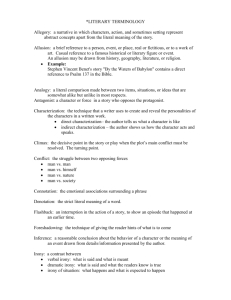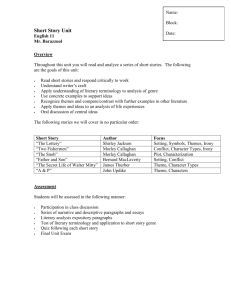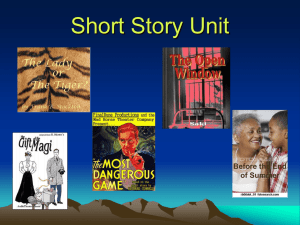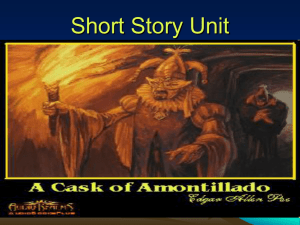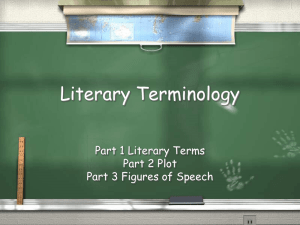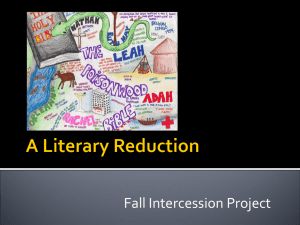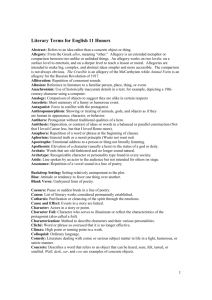LITERARY TERMINOLOGY
advertisement
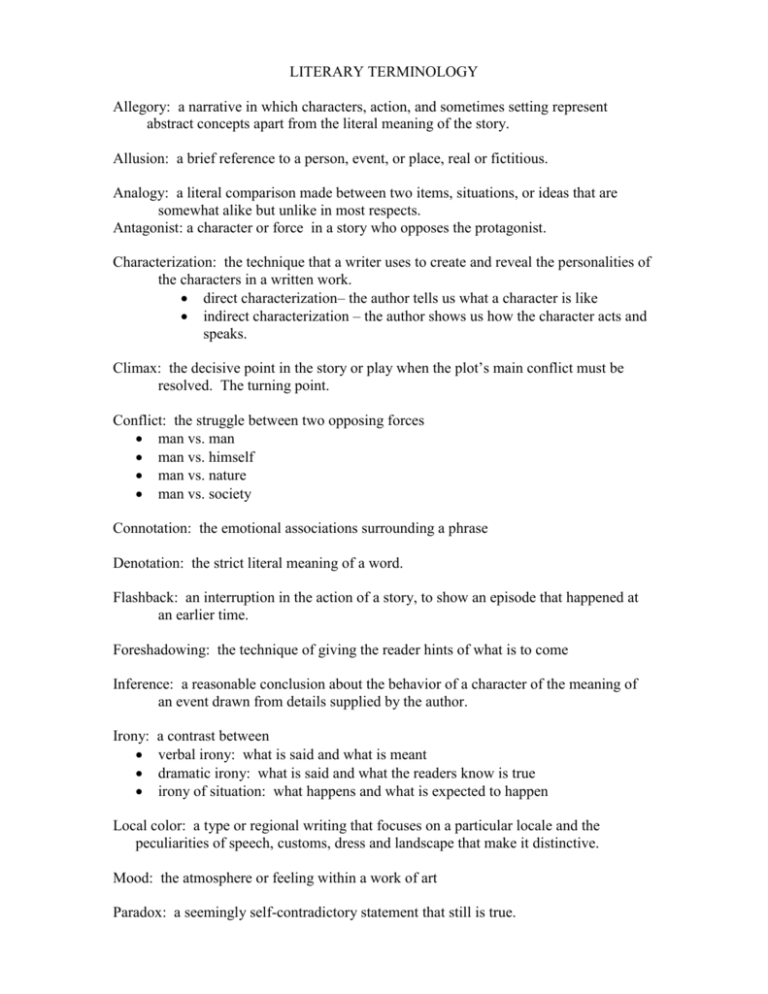
LITERARY TERMINOLOGY Allegory: a narrative in which characters, action, and sometimes setting represent abstract concepts apart from the literal meaning of the story. Allusion: a brief reference to a person, event, or place, real or fictitious. Analogy: a literal comparison made between two items, situations, or ideas that are somewhat alike but unlike in most respects. Antagonist: a character or force in a story who opposes the protagonist. Characterization: the technique that a writer uses to create and reveal the personalities of the characters in a written work. direct characterization– the author tells us what a character is like indirect characterization – the author shows us how the character acts and speaks. Climax: the decisive point in the story or play when the plot’s main conflict must be resolved. The turning point. Conflict: the struggle between two opposing forces man vs. man man vs. himself man vs. nature man vs. society Connotation: the emotional associations surrounding a phrase Denotation: the strict literal meaning of a word. Flashback: an interruption in the action of a story, to show an episode that happened at an earlier time. Foreshadowing: the technique of giving the reader hints of what is to come Inference: a reasonable conclusion about the behavior of a character of the meaning of an event drawn from details supplied by the author. Irony: a contrast between verbal irony: what is said and what is meant dramatic irony: what is said and what the readers know is true irony of situation: what happens and what is expected to happen Local color: a type or regional writing that focuses on a particular locale and the peculiarities of speech, customs, dress and landscape that make it distinctive. Mood: the atmosphere or feeling within a work of art Paradox: a seemingly self-contradictory statement that still is true. Plot: a series of related events that present and resolve a conflict (conflict – climaxresolution) Point of view: the relationship between the narrator and the characters first person: narrator offers an account of his experiences or tells what happens to other characters – (I) third person objective: narrator describes only what can be seen (one view) third person omniscient: all- knowing narrator Protagonist: the leading character of a literary work Resolution: the part of the plot in which the conflict is resolved Satire: a technique that employs with to ridicule a subject (humor + sarcasm-satire) Setting: the time and place in which the action of the narrative occurs Stereotype: standardized, conventional ideas about plots, settings, and characters. Symbol: something concrete that represents something abstract. Theme: the underlying meaning of literary work (stated in one sentence) Tone: the author’s attitude toward the subject of his or her literary work. Vignette: short, sketchy, short story. Alliteration: the repetition of initial consonant sounds in neighboring words. Allusion: a brief reference to a person, event, or place, real or fictitious, or to a work of art. Casual reference to a famous historical or literary figure or event. An allusion may be drawn from history, geography, literature, or religion. Example: Stephen Vincent Benet's story "By the Waters of Babylon" contains a direct reference to Psalm 137 in the Bible. Assonance is the repetition of vowel sounds. Example: fleet feet sweep by sleeping geeks. Genre: A literary type or form. Drama is a genre of literature. Within drama, genre include tragedy, comedy and other forms. Hyperbole: A figure of speech in which an overstatement or exaggeration occurs. Example - lines from Act 2, scene 2 of Shakespeare's "Macbeth." In this scene, Macbeth has murdered King Duncan. Horrified at the blood on his hands, he asks: Will all great Neptune's ocean wash this blood Clean from my hand? No. This my hand will rather The multitudinous seas incarnadine, Making the green one red. Simile: a figure of speech wherein a comparison is made between two unlike quantities with the use of the words “like” or “as”. Example – Bob was as tall as a tree. Metaphor: A figure of speech wherein a comparison is made between two unlike quantities without the use of the words "like" or "as." Example-Bob was a tree of a man. Understatement: statement which lessens or minimizes the importance of what is meant. For example, if one were in a desert where the temperature was 125 degrees, and if one were to describe thermal conditions saying "It's a little warm today." that would be an understatement. Motif: a recurring object, concept, symbol, or structure in a work of literature. Personification: A figure of speech in which something nonhuman is given human characteristics. Consider the following lines from Carl Sandburg's "Chicago:" Stormy, husky, brawling, City of the big shoulders: Pun: A play on words wherein a word is used to convey two meanings at the same time. The line below, spoken by Mercutio in Shakespeare's "Romeo and Juliet," is an example of a pun. Mercutio has just been stabbed, knows he is dying and says: Ask for me tomorrow and you shall find me a grave man. Onomatopoeia: A literary device wherein the sound of a word echoes the sound it represents. The words "splash." "knock," and "roar" are examples. Oxymoron: A combination of contradictory terms, such as used by Romeo in Act 1, scene 1 of Shakespeare's "Romeo and Juliet:" Why then, O brawling love! O loving hate! O heavy lightness, serious vanity; Misshapen chaos of well-seeming forms! Feather of lead, bright smoke, cold fire, sick health!

